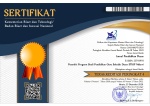IDENTIFICATION OF FINE MOTOR SKILLS IN CHILDREN WITH INTELECTUAL DISABILITY
Abstract
Abstract: The purpose of this study was to describe fine motor skills in mentally retarded children. This study involved 20 mentally retarded children in special schools (SLB) in North Lombok. Identification was carried out using several data collection techniques, namely through observation, filling out instruments and interviewing the teacher. Identification of mentally disabled children focuses on several fine motor skills, namely: making curved lines, making horizontal lines, making circle patterns, cutting straight line pattern paper, cutting zigzag pattern paper, cutting circle pattern paper, cutting square pattern paper, simple drawing, coloring using colored pencils, coloring using crayons, and coloring using watercolors. The results of the study used descriptive analysis with two categorizations. Based on the results of the analysis, it was found that out of 20 mentally retarded children can be categorized as follows: on average 68% of children are in the Start Development category (MB), which means that children are starting to be able to do activities, but still with the help of teachers and 32% of children fall into the Developing Appropriate category Hope (BSH). Thus, through this identification it can improve fine motor skills in mentally retarded children by using other interesting methods or strategies.
Keywords: skill, finemotor, intelectual disability
Full Text:
PDFReferences
Azizah,S., & Wati, S. E/ (2014). Upaya Menurunkan Tingkat Stres Hospitalisasi dengan Aktifitas Mewarnanai Gambar Pada Anak Usia 4-6 tahun di Ruang Anggrek RSUD Gambiran Kediri. Jurnal No 25 Volume, 1, 6- 10.
Cameron, C. E., dk. (2012). Fine Motor Skill and Executive function both contribute to kindergarten achievement.
Child Development, 83(4), 1229-1224
Case-Smith, J. (1995). The relationship among sensorimotor component, fine motor skill, and functional in preschool children. American Journal of Occupational Therapy, 49 (7), 645-652)
Decaprio, R. (2013). Aplikasi Teori Pembelajaran Motorik di Sekolah. Jogjakarta: Diva Press. Delphie, B. (2006). Pembelajaran Anak Tunagrahita. Bandung: PT Refika Aditama.
Elcombe, E. (2017). Effect of Practical Life Exercises on Fine Motor Development in a Montessori Childrens’ House Classroom. University of Wisconsin-River Falls.
Grismer, dkk. (2010). Fine Motor Skill and Early Comprehension of the world: two new school readiness indicators,
Developmental Psychology, 46 (5), 1008.
Gustek, Gerald. 2013. Metode Montessori (Panduan Wajib untuk guru dan Orangtua didik PAUD). Yogjakarta: Pustaka Belajar.
Hainstock. E. (2002). Montessori untuk sekolah dasar. Bandung:Delapratasa Publishing
Hunt, Nancy dan Marshall. Kathleen. 2005. Exceptional Children Youth. USA:Houghton Mifflin Campany Hunt, Nancy dan Marshall. (2005). Exceptional Children and Youth. USA: Houghton Mifflin Company
Kemis., Rosnawati, A., (2013). Pendidikan Anak Berkebutuhan Khusus Tunagrahita. Jakarta Timur: PT Luxima Metro Media.
Mahmudah, H. (2015). Mengembangkan Motorik Halus melalui Kegiatan Menggunting Kertas Mengikuti Pola GarisLurus Pada Anak Usia 3-4 tahun diKelompok Bermain Bunga Mulia Slumbang Kecamatan Ngadiluwih Kabupaten Kediri.
Lailah. I., & Khotimah, N. (2013). Upaya Meningkatkan Kemampuan Motorik Halus Anak Melalui Menggunting dan Menempel di Kelompok B TK Muslimat 2 Jombang. Jurnal Paud Teratai, 2(3)
Montessori, Maria. (1914). Dr. Montessori’s Own Handbook. New York: Frederick A. Stokes Company Pulishers.
Montessori, Maria. (2013). Metode Montessori. Panduan Wajib Untuk Guru dan Orangtua Ddidik PAUD (Pendidikan Anak Usia Dini. Yogjakarta: Pustaka Belajar.
Paramita, Vidya Dwina. (2017). Jatuh Cinta Pada Montessori: Seni Mengasuh Anak Usia Dini. Yogyakarta: Penerbit B first. Permendikbud no 12 tahun 2018. Renstra Pendidikan tahun 2015-2018.
Rahyubi, Heri. (2012). Teori-Teori Belajar dan Aplikasi Pembelajaran Motorik. Majalengka: Penerbit Referens. Reni Akbar-Hawadi (2002). Identifikasi Keberbakatan Intelektual Melalui Metode Non tes. Jakarta:Grasindo.
Reichbow, Brian. 2006. Handbook Early Chilhood Spesial Education. USA: Springer.
Rohendi, A., Seba, L., (2017). Perkembangan Motorik (Pengantar Teori dan Aplikasinya dalam Belajar). Bandung: Penerbit Alfabeta.
Sukamti. (2014). Upaya Meningkatakn Motorik Halus Melalui Kegiatan Menggambar Pada Anak Kelompok B TK Dharma Wanita 2 Patihan Sidoharjo Sragen.
Somantri, S. (2002). 2006. Psikologi Anak Luar Biasa. Bandung: Refika Aditama
Warnida. (2017). Upaya Meningkatkan Kemampuan Motorik Halus Melalui Kegiatan Mewarnai di Kelompok B1 TK Berkah Kota Jambi. Jurnal Ilmiah Dikaya, 9 (1), 132-140
DOI: https://doi.org/10.46368/jpd.v9i1.354
Article Metrics
Abstract view : 194 timesPDF - 175 times
Refbacks
- There are currently no refbacks.
Copyright (c) 2021 JURNAL PENDIDIKAN DASAR

This work is licensed under a Creative Commons Attribution-ShareAlike 4.0 International License.
Contact:
Mastiah, email: jurnalpendidikandasar2010@gmail.com
STKIP Melawi Jl. RSUD Melawi Km. 04. Kec. Nanga Pinoh Kab. Melawi
__________________________________________________________

This work is licensed under a Creative Commons Attribution-NonCommercial-ShareAlike 4.0 International License.







